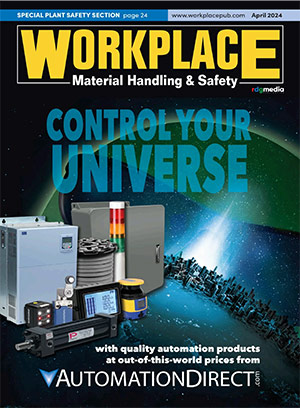Managing Inventory with an Automated Storage and Retrieval System
By Dan Labell, President, Westfalia Technologies, Inc.
 To remain competitive and prepare for the future, warehouse operators are focused today on maximizing efficiencies and minimizing expenses by optimizing warehouse space, reducing labor costs and increasing order accuracy. In order to reap these benefits, operators need to turn to warehouse automation technology.
To remain competitive and prepare for the future, warehouse operators are focused today on maximizing efficiencies and minimizing expenses by optimizing warehouse space, reducing labor costs and increasing order accuracy. In order to reap these benefits, operators need to turn to warehouse automation technology.
By integrating a high-density automated storage and retrieval system (AS/RS) with a warehouse execution system (WES), manufacturers can better manage their inventory to obtain accurate, real-time information on products moving throughout the warehouse to increase efficiency and decrease the time to market for its brands.
The WES includes a tightly integrated warehouse management system (WMS) and warehouse control system (WCS) to help manufacturers and distributors direct, control and optimize material flow and order fulfillment. This two-in-one solution performs the tasks of both systems through a single solution. Its modular design enables companies to use only the functions needed to handle their immediate warehousing needs—ranging from full traceability of inventory to fully automating the warehouse with an AS/RS.
Although many operators are already adopting warehouse automation solutions, some are still hesitant. Many companies presume that automation is too expensive or too large for their operations. Some companies put off the investment of automation as a way to achieve their short term goals and are more focused on a “quick fix” instead of a long-term solution. Regardless of the misconceptions of automated technology, investing in an AS/RS is essential to efficient order fulfillment, labor reduction and maximizing storage capacity.
Improving Order Fulfillment
Due to the complexity of orders and ever-decreasing order turnaround times, order fulfillment has become a complicated task with no room for errors. To meet these demands, distributors, manufacturers and even retailers are often under pressure to fulfill orders within a short period of time while maintaining order accuracy.
The measurement of success for an order fulfillment process is heavily dependent upon the design of the warehouse and the efficiency of the picking process. Automated warehouse systems allow manufacturers to integrate efficient order fulfillment processes and workflows to enhance warehouse performance and minimize labor. By integrating an AS/RS with warehouse materials handling and management systems, picking processes can be drastically simplified and can significantly improve order fulfillment logistics. For greater efficiency, combine an AS/RS with a picking system to systematically pick products, layers and cases from the inventory to palletize and ship to the consumer. Today’s advanced warehouse automation solutions are customizable to accommodate any order-picking strategy and establish efficient picking processes, routes and sequences for a better overall performance of the warehouse.
Reducing Labor
 Order picking is undoubtedly a laborious task no matter where your operations are housed. Automating the picking process dramatically reduces labor requirements and travel times and reduces the risk of error— leading to cost savings in the long run.
Order picking is undoubtedly a laborious task no matter where your operations are housed. Automating the picking process dramatically reduces labor requirements and travel times and reduces the risk of error— leading to cost savings in the long run.
The integration of warehouse material handling systems, with a high-density AS/RS, greatly simplifies the picking processes used to improve order fulfillment. For example, a worker is tasked with fulfilling an order containing a variety of SKUs, located all over the warehouse. The worker then walks though racks to find the products. If the warehouse is large or the products are far apart, it will significantly increase the travel time and increase labor costs.
Rather than having a person take time to travel between various locations to pick requested products for an order, an AS/RS could provide a “Goods to Person” approach to order picking. An efficient automated process might couple a high-density AS/RS with other technology to systematically pick full pallets, layers and cases from the inventory to fulfill a customer order. The system ensures that the necessary products are available to the picker as needed, often travelling over vast distances, moving both horizontally and vertically, in a short amount of time.
In addition to reducing manual labor costs, an AS/RS helps keep workers safe. There is no longer a need for repetitive lifting, and forklifts are not driving around in the same aisles as people. An AS/RS is especially beneficial for picking in cold and freezer environments where temperatures are often too harsh for the human body. Also, with an AS/RS there is no need to take precautions by closing an aisle or area of the warehouse to pick items from the top self, so operations are able to continue running smoothly and accidents are significantly reduced.
Maximizing Storage Capacity
A huge obstacle to optimizing warehouse efficiency and reducing the costs associated with demand-based replenishment is storage space. Finding alternatives to house thousands of SKUs within the least amount of real estate is a challenge facing many companies today. By implementing a high-density AS/RS, manufacturers will be able to store more product in the same amount of space and eliminate the need for new construction or off-site storage—costly options that produce little ROI. Including an AS/RS in new construction can minimize the overall building footprint by up to 50 percent, when compared to a conventional warehouse.
At the same time, the system will better-position a facility for growth since the warehouse has the room to accommodate increased product quantities and SKUs. Since an AS/RS allows for better space utilization, companies can further cut costs by consolidating several smaller, disparate warehouse facilities. By combining operations from remote locations into a centralized warehouse, companies will reduce costs associated with additional labor, resources and energy consumption.
When pick tunnels are integrated in the high-density warehouse, companies can reduce the travel time, achieve better product availability and maximize existing real estate. Not only is picking more efficient, but so is the overall use of warehouse space, generating savings for years. Plus, in cold storage facilities, automation can strictly control all picking movements and processes within the cold environment. Since workers no longer entering and exiting fridges and freezers, temperatures are more easily maintained with less energy¾resulting in significant savings in energy consumption.
Every business has its own processes and solutions, so a “one-size-fits-all” system will not always work. A high-density AS/RS has the ability to simplify and execute different processes inside of the same building footprint. Combining different picking strategies, automated and manual order fulfillment technologies, and warehouse management software, such as a WES, often best sets the business up for success.



